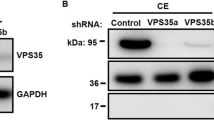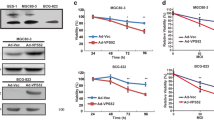Abstract
Vesicular Over-expressed in cancer Prosurvival Protein 1 (VOPP1), also known as Glioblastoma Amplified and Secreted Protein and EGFR-Coamplified and Over-expressed Protein has been previously shown to be over-expressed in human glioblastoma multiforme and squamous cell carcinoma. Additionally, previous experimental work suggests that it confers a prosurvival cellular phenotype. A query of a public database of gene expression profiling data (Oncomine™) shows that the VOPP1 transcript is also highly expressed in several other common human cancers, including breast carcinoma, pancreatic carcinoma, and lymphoma. Analysis of VOPP1 sequence structure shows both a signal sequence and a transmembrane domain, and examination of a public microarray dataset for endoplasmic reticulum (ER)-bound mRNA transcripts is consistent with the VOPP1 protein product being synthesized into the ER. Immunoblot analysis of cell culture and conditioned media confirms that the protein product is not secreted and is retained intracellularly. VOPP1 protein tagged with a fluorescence reporter, as well as antibody-mediated visualization of recombinant and native forms of the protein reveals an intracellular vesicular pattern of localization. Co-localization experiments reveal that VOPP1 vesicles do not co-localize with mitochondria or peroxisomes, but show partial co-localization with perinuclear lysosomes. Additionally, markers of endocytosis and autophagy show partial perinuclear co-localization, suggesting that VOPP1-containing vesicles enter final common pathways of the lysosomal system. These findings throw into doubt the hypothesis that VOPP1 interacts directly with cytoplasmic mediators of the NF kappa B pathway, and suggest that the prosurvival phenotype conferred by this gene product is mediated by other mechanisms.








Similar content being viewed by others
References
Asanuma K, Tanida I et al (2003) MAP-LC3, a promising autophagosomal marker, is processed during the differentiation and recovery of podocytes from PAN nephrosis. FASEB J 17(9):1165–1167
Bannasch D, Mehrle A et al. (2004) LIFEdb: a database for functional genomics experiments integrating information from external sources, and serving as a sample tracking system. Nucleic Acids Res 32(Database issue): D505–8
Baras A, Yu Y et al. (2009) Combined genomic and gene expression microarray profiling identifies ECOP as an upregulated gene in squamous cell carcinomas independent of DNA amplification. Oncogene
Barrett T, Suzek TO et al. (2005) NCBI GEO: mining millions of expression profiles–database and tools. Nucleic Acids Res 33(Database issue): D562–6
Bendtsen JD, Nielsen H et al (2004) Improved prediction of signal peptides: SignalP 3.0. J Mol Biol 340(4):783–795
Bkaily G, Pothier P et al (1997) The use of confocal microscopy in the investigation of cell structure and function in the heart, vascular endothelium and smooth muscle cells. Mol Cell Biochem 172(1–2):171–194
Chen JW, Murphy TL et al (1985) Identification of two lysosomal membrane glycoproteins. J Cell Biol 101(1):85–95
Cresawn KO, Potter BA et al (2007) Differential involvement of endocytic compartments in the biosynthetic traffic of apical proteins. EMBO J 26(16):3737–3748
Cuervo AM (2004a) Autophagy: in sickness and in health. Trends Cell Biol 14(2):70–77
Cuervo AM (2004b) Autophagy: many paths to the same end. Mol Cell Biochem 263(1–2):55–72
De Duve C, Wattiaux R (1966) Functions of lysosomes. Annu Rev Physiol 28:435–492
Eley GD, Reiter JL et al (2002) A chromosomal region 7p11.2 transcript map: its development and application to the study of EGFR amplicons in glioblastoma. Neuro-oncol 4(2):86–94
Gonatas NK, Stieber A et al. (1984) Endosomes and Golgi vesicles in adsorptive and fluid phase endocytosis. J Cell Biol 99(4 Pt 1): 1379–90
Guicciardi ME, Leist M et al (2004) Lysosomes in cell death. Oncogene 23(16):2881–2890
Imanaka T, Aihara K et al. (2000) The 70-kDa peroxisomal membrane protein (PMP70), an ATP-binding cassette transporter. Cell Biochem Biophys 32(Spring):131–8
Imanaka T, Shiina Y et al (1996) Insertion of the 70-kDa peroxisomal membrane protein into peroxisomal membranes in vivo and in vitro. J Biol Chem 271(7):3706–3713
Kabeya Y, Mizushima N et al (2000) LC3, a mammalian homologue of yeast Apg8p, is localized in autophagosome membranes after processing. EMBO J 19(21):5720–5728
Keij JF, Bell-Prince C et al (2000) Staining of mitochondrial membranes with 10-nonyl acridine orange, MitoFluor Green, and MitoTracker Green is affected by mitochondrial membrane potential altering drugs. Cytometry 39(3):203–210
Krogh A, Larsson B et al (2001) Predicting transmembrane protein topology with a hidden Markov model: application to complete genomes. J Mol Biol 305(3):567–580
Matsumoto N, Tamura S et al (2003) Mutations in novel peroxin gene PEX26 that cause peroxisome-biogenesis disorders of complementation group 8 provide a genotype-phenotype correlation. Am J Hum Genet 73(2):233–246
Mechler BM (1987) Isolation of messenger RNA from membrane-bound polysomes. Methods Enzymol 152:241–248
Park S, James CD (2005) ECop (EGFR-coamplified and overexpressed protein), a novel protein, regulates NF-kappaB transcriptional activity and associated apoptotic response in an IkappaBalpha-dependent manner. Oncogene 24(15):2495–2502
Poot M, Zhang YZ et al (1996) Analysis of mitochondrial morphology and function with novel fixable fluorescent stains. J Histochem Cytochem 44(12):1363–1372
Raub TJ, Koroly MJ et al (1990) Endocytosis of wheat germ agglutinin binding sites from the cell surface into a tubular endosomal network. J Cell Physiol 143(1):1–12
Rhodes DR, Yu J et al (2004) ONCOMINE: a cancer microarray database and integrated data-mining platform. Neoplasia 6(1):1–6
Simpson JC, Wellenreuther R et al (2000) Systematic subcellular localization of novel proteins identified by large-scale cDNA sequencing. EMBO Rep 1(3):287–292
Sonnhammer EL, von Heijne G et al (1998) A hidden Markov model for predicting transmembrane helices in protein sequences. Proc Int Conf Intell Syst Mol Biol 6:175–182
Stitziel NO, Mar BG et al (2004) Membrane-associated and secreted genes in breast cancer. Cancer Res 64(23):8682–8687
Tanida I, Ueno T et al (2008) LC3 and autophagy. Methods Mol Biol 445:77–88
Acknowledgments
We wish to thank Angela Miller of the University of Virginia’s Biorepository and Tissue Research Facility for support of the histologic techniques required to carry out these studies. Alex Baras is a member of the Biotechnology Training Program at The University of Virginia, supported by training grant T32 GM008715 from the National Institutes of Health (USA). These studies were primarily supported by a grant from the Virginia Tobacco Settlement Foundation. This project was also supported in part by a gift provided to the University of Virginia by Philip Morris USA. The review and approval process was overseen by an External Advisory Committee without any affiliation with the University, PM USA, or any other tobacco company. Funding for this project was based upon independent intramural and extramural reviews.




